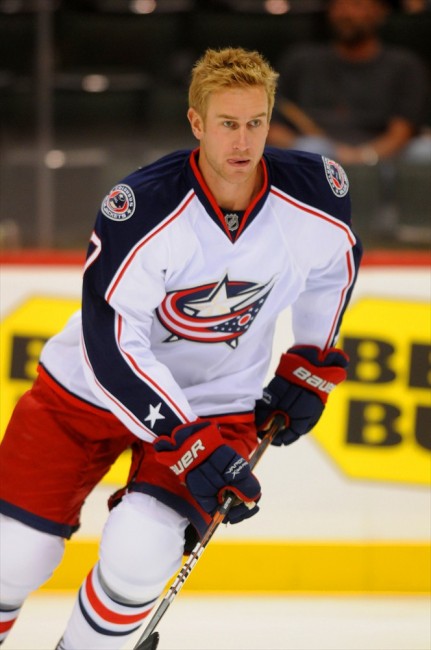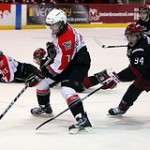
On June 23 Columbus Blue Jackets general manager Scott Howson pulled off the biggest move of his tenure trading young winger Jakub Voracek and the club’s first and third round draft picks in the 2011 NHL draft to the Philadelphia Flyers in exchange for center Jeff Carter. At the time Blue Jackets fans felt that Howson had finally secured the number one center to play with Rick Nash the team had always been looking for. The reaction of Flyers fans was mixed between those happy to see Carter leave and those that thought the return for a former all-star center was not enough. The situation drew even more attention when Carter refused to speak to the media following the trade, fueling rumors that he was furious and could possibly refuse to report to Columbus. The reality was that Carter’s anger was not directed at the Blue Jackets, but at the Philadelphia Flyers, and namely general manager Paul Holmgren. Carter had just signed an eleven-year contract extension the year before at a somewhat discounted price to stay in Philadelphia and help the organization save some money to sign other players. The deal had a no-trade clause, however as the rules of the current CBA do not allow players to have them in their deals before they are eligible for unrestricted free agency, the clause was not due to go into effect until 2012. In the summer the Flyers obtained goaltender Ilya Bryzgalov from the Phoenix Coyotes and needed to move some salary to sign him. Trade rumors swirled around Carter, and his agent Rick Curran was repeatedly assured by Holmgren that the Flyers were not looking to move him. Holmgren even met with Curran and Carter to re-assure him that he was not going to be traded. Two weeks later however, Holmgren did just that. While still too early to pass final judgement on the trade, so far this season it would appear that Philadelphia got the better end of the deal.
The centerpiece of the deal for the Flyers was former first-round draft pick Jakub Voracek. Voracek has been good for Philadelphia,

putting up 5-16-21 +6 in 34 games, however he continues to exhibit the same issues that caused the Blue Jackets to consider him expendable, namely inconsistency and regularly missing the net (7.1% shooting percentage tied for 369th in the league). Voracek is more of a playmaker than a scorer, but he never seemed to gel with Nash while playing on the first line and the Blue Jackets brass thought that conditioning was an issue for the youngster. At the conclusion of the 2010-11 season head coach Scott Arniel told the Columbus Dispatch “The biggest thing that is holding him back is his conditioning, I think this guy can be an elite player in this league if he gets himself in shape.” The other piece of the deal from the Blue Jackets end was their first-round selection, the eight overall in the 2011 NHL draft. The Blue Jackets are notoriously bad at drafting and developing players, so at the time the pick seemed like a reasonable asset to give up. The Flyers got lucky when Sean Couturier a big-bodied center who had dominated the QMJHL fell into their lap. Surprisingly Couturier made the Flyers team out of training camp and has been quite good for a rookie so far this season putting up 5-4-9 +9 in 34 games. When Couturier scored his first NHL goal in his third game, the primary assist went to none other than Jakub Voracek.
On the Blue Jackets end Jeff Carter appeared to be the type of player the Blue Jackets had been searching for since their inception, a legitimate center that could play on the top line. Once the excitement subsided and people began to look at the type of player the Blue Jackets acquired it became evident that Carter and Nash might not be the lethal combination everyone thought. The one telling stat that caused some concern was shots on goal. In 2010-11 Carter launched 335 shots on goal, good for third in the league while Nash managed 305 which placed him sixth. In 2009-10 Carter also placed third in the league with 319 shots on goal while Nash placed twenty-fifth with 254 shots on net. The stats speak for themselves, the Blue Jackets newest acquisition was a shoot-first center, not a playmaker. The Blue Jackets had two playmakers that could play on a line with Nash and Carter, unfortunately the Blue Jackets had just traded one of them to the Flyers, Jakub Voracek. The Blue Jackets intended their top line to include the other playmaker, Kristian Huselius. On July 13 Huselius was working out in Sweden, rehabbing from groin surgery he underwent in April, when he tore a pectoral muscle. With Huselius out for an extended time the Blue Jackets signed free agent Vinny Prospal to take his place. Prospal has proven to be an effective replacement, but he is not the playmaker Huselius is. Huselius came back (some might say was rushed back) for two games in December during which he was mainly ineffective before he was injured again. While it is entirely within the realm of possibility that having a healthy Huselius on their line with them would create more offense, Nash and Carter are not exhibiting the type of chemistry the team needs from two players making a combined $13 million. Both players are on pace for statistically poor seasons, 48 points for Carter (who has missed some games with a fracture in his foot) and 57 for Nash, with both players firmly in the negative +/-. That is significantly below the expected level of play for two players of their caliber making the amount of money they make. It is especially frustrating to see the defensive issues the line has had. Nash was a horrible two-way player early in his career putting up a combined -62 during his first two seasons in the NHL. After committing to playing a better two-way game under former head coach Ken Hitchcock, Nash was a combined +5 over the last five seasons. Carter was a +51 for his career coming into this season and is generally considered a good two-way player.
With everything taken into consideration, should the Blue Jackets have made the trade? With only half a season having passed, it is hard to argue that the Blue Jackets received the better end of the deal, but I would still argue that they likely came out of the trade with the best player. With their history of draft busts and failures and actually having a surplus of centers it is possible the Blue Jackets would not have selected Couturier at all. It is possible they would have drafted one of the defensemen that went in the next few picks like Dougie Hamilton or Ryan Murphy. They also could have looked for another player instead of Carter, perhaps Mike Richards who the Flyers traded to the Los Angeles Kings would have been a better target to acquire and play with Nash, someone who is better known for being a playmaking pivot. With the situation the Blue Jackets are in, it is entirely possible that one or even both of Carter and Nash are shipped out to start rebuilding around the younger players the team possesses like Ryan Johansen, John Moore, and Matt Calvert. If the trade is to be judged by the results the teams have had since, then the Flyers easily won.